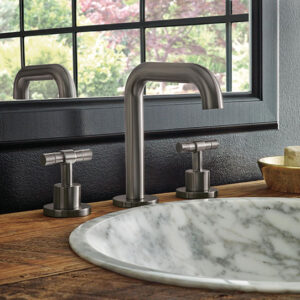Specifying restrooms for heavy-use uses such as airports, schools, and stadiums requires a sensitive balance between performance, sustainability, and long-term durability. Architects and engineers are now required to deliver solutions that conserve water and energy, deliver hygiene, comfort, and operating efficiency. The sustainable restroom design process goes far beyond product specification — it’s an overall-building approach that integrates materials, technologies, and lifecycle planning.
Securing Water Conservation in Public Restrooms
The building block of any eco-friendly bathroom is water conservation. Architects push fixtures that are at least EPA WaterSense certified to cut usage without sacrificing performance. One such great example is BathSelect’s low-flow automatic faucet line that’s built for airports and public restrooms where usage is constant. Another is FontanaShowers’ sensor faucet line that uses accurate infrared sensing to control flow and conserve water without sacrificing user satisfaction.
Technologies such as Sloan’s high-efficiency valve systems and Kohler water-saving bathroom innovations have set the global standard for green plumbing, allowing architects to strike a balance between dependability and measurable conservation.
Durability as a Strategy for Sustainability
Longevity is sustainability writ large at the level of large projects. Repairable fixtures prolong the life of a building and reduce resource-penalizing replacement. FontanaShowers’ commercial-grade faucet systems, built with solid brass and modular parts, illustrate how repairability contributes to the bottom line.
Sensor fixture line of Bravat, with vandal-resistant housings that are well-suited to stadiums and transit hubs, provides long-term integrity even with heavy use. Likewise, Zurn’s water-saving plumbing has replaceable electronics that minimize maintenance, lowering overall lifecycle cost and environmental impact.
Hygienic Design Through Touchless Technology
Public hygiene is being equated with sustainability objectives. Touchless solutions save water and abrasive cleansers by preventing surface contact. Bravat’s series of intelligent faucet line combines sensor-responsive control with a clean design ethic, responding to both aesthetic and performance needs. In schools, BathSelect’s touchless automatic soap dispensers foster improved student personal hygiene practices and less product waste. For design groups engaged in sensor reliability benchmarking research, Toto’s EcoPower line and Sloan’s touchless washroom systems best practices and existing literature are sound examples of low-custody, high-efficiency automation.
Smart Building Integration and Building Management Compatibility
The restrooms of the future are smart building integration. Telemetry-mounted fixtures can be equipped with real-time information regarding water usage, battery life, and frequency of use.
FontanaShowers’ BIM resource center enables building managers to incorporate Revit-compliant fixture models into building management systems, which are able to monitor usage correctly and trigger maintenance notifications. Other products that share similar functionality include Zurn’s networked plumbing intelligence and Kohler’s Konnect commercial system, which enable proactive facility management and sustainability reporting for large facilities.
Choosing Responsible Materials for Health and Longevity
Sustainability goes well beyond water saving — wise material choice is part of it too. Lead-free brass, stainless steel, and PVD finishes add to durability and indoor air quality. BathSelect’s environmentally responsible manufacturing adheres to international LEED and WELL certification. Fontana’s commercial product line uses anti-corrosive finishes that use less labor, reducing chemical and water use in cleaning.
Architects always draw on the EPA WaterSense technical resources and the WELL Building Standard standards in such a manner that material and performance requirements are in harmony with overall sustainability goals.
Greywater Systems and Resource Reuse
Where water demand is enormous in airports and stadiums, greywater recovery systems can make a considerable impact on potable water use. There needs to be a uniform fixture flow rate for these systems to function properly. Fontana’s metered faucet designs assist with continuous output for reuse collection. Systems integration, such as Sloan’s flushometers and Zurn’s water reuse management systems, demonstrates how architecture and mechanical engineering converge to deliver closed-loop water solutions — of interest to facilities with net-zero water projects in the works.
Maintainability and Architectural Support
Achievement with sustainability depends on easy-to-maintain products backed by robust technical support. FontanaShowers’ Architectural Support Program helps contractors and design groups with installation data, BIM coordination, and AIA-approved training.
Twin offerings, including Kohler professional specification services and Sloan engineering support center, reflect a shared industry commitment to ongoing education and transparency of products — a consideration of significance to architects who want to preserve specifications intact from project start to finish.
Educational Spaces and Sustainable Awareness
In schools, green restroom design has double its advantage — environmental conservation and learning. Sensor faucets with visible valves, low-flow fixtures, and natural ventilation systems model environmental responsibility for students. Architects and educators can utilize materials of the American Institute of Architects (AIA) and Plumbing Manufacturers International (PMI) to promote responsible design practices in school buildings.
Conclusion: Responsible Design for the Public Good
Sustainable bathroom design for airports, schools, and stadiums is all about providing high-performing spaces that do good for mankind as well as the earth. With the help of water-conserving technologies, durable materials, and smart management systems, architects are able to reduce environmental impacts and increase operational performance.
Companies like BathSelect, FontanaShowers, and BravatShowers demonstrate that sustainability is not just a reality if design, technology, and performance are coupled with measurable outcomes. They, along with the likes of visionaries such as Sloan, Kohler, Toto, and Zurn, are revolutionizing the next generation of sustainable buildings — where every drop, finish, and fixture tells the story of wise design and earth stewardship.

No responses yet